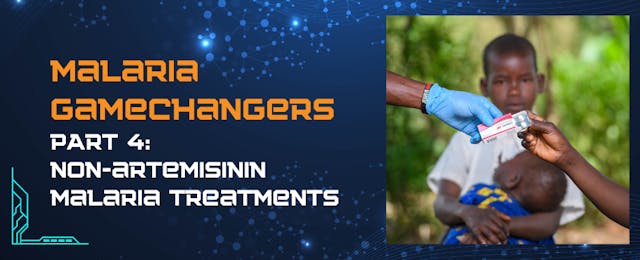

Part 4 of our Malaria Gamechangers series (check out Episodes 1-3) highlights a new family of malaria medicines being developed to combat the growing threat of anti-malarial drug resistance.
Throughout history, malaria drugs have repeatedly been compromised by antimicrobial resistance. In the wake of widespread Chloroquine resistance, artemisinin-based combination therapy (ACT) has become the first-line treatment in almost all malaria-endemic countries over the past two decades. But in recent years, the emergence of artemisinin resistance in sub-Saharan Africa and southeast Asia has fueled urgency to develop new, non-artemisinin therapies – drugs that will serve as complementary therapies to ACT, thus mitigating the spread of artemisinin resistance.
United to Beat Malaria’s Jonathan Kidwell interviewed George Jagoe, Executive Vice President of Access and Product Management at Medicines for Malaria Venture (MMV), at the 2022 American Society of Tropical Medicine and Hygiene Annual Meeting in Seattle. You can watch the film and read the full interview below.
Mr. Kidwell: George, why are next-generation treatments a gamechanger in the fight against malaria?
Mr. Jagoe: So we’ve really been living through a remarkable 20-year honeymoon period of using artemisinin-based treatments to deal with uncomplicated malaria treatments.
The combination therapies with artemisinin called ACT’s are remarkably effective so we are grateful, the world is lucky, to have had this family of medicines. The problem is, there are growing signs that artemisinin – as the backbone for these treatments which has, been such a remarkable curative force – is being undermined by the threat of resistance.
So what’s the real gamechanger for us is being assured that we have a non-artemisinin family of medicines coming through the R&D pipeline. We hope ACT’s will be with us for decades more but it’s not prudent to bank on that. Resistance always comes to malaria drugs eventually. So the gamechangers are: what can we bring to the market that will not be based on artemisinins? And that’s really driving the R&D ambitions that we and other organizations have.
Mr. Kidwell: And are there any non-artemisinin therapies currently being tested, and if so – where?
Mr. Jagoe: So right now, the most advanced ones are in Phase 2. That means they’ve already been proven to be safe in humans, and we’ve seen early signs of efficacy. A Phase 3 program is really when you take drugs into … thousands of people to confirm that they are gonna be as good as we hope and as safe as we hope. So there’s no Phase 3 programs yet, but we expect one to start within the next 18 months with a non-artemisinin combination, but there should be several more in the next five to seven years.
So we’re keeping up with the war against resistance, but we don’t have time to lose.
Mr. Kidwell: And what is the long-term goal for these next-generation therapies? And what potential roadblocks do you see in achieving those goals?
Mr. Jagoe: So the roadblocks would be if they’re not proving as effective as [ACT’s]. So we’re quite insistent that we need to have drugs as effective as today’s ACT’s. Roadblocks could be then if we run into difficulties with finding the right compounds, though we’re fairly optimistic.
The other roadblocks would be is if new products come in and they’re relatively expensive. The world today is used to very effective, very affordable ACT medicines and we might have to cope with the challenge of new products that are more expensive at least at launch, to make sure there’s mechanisms to make them available.
Stay tuned as we highlight a new Malaria Gamechanger each week throughout May!